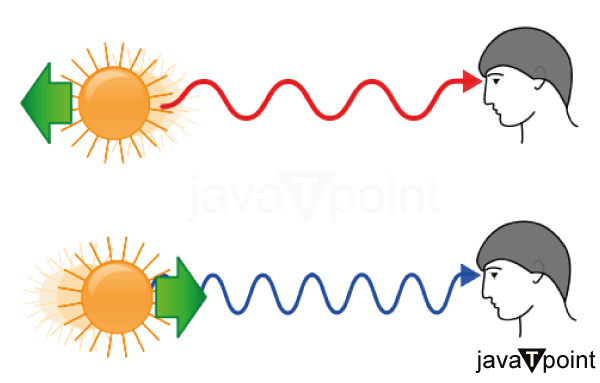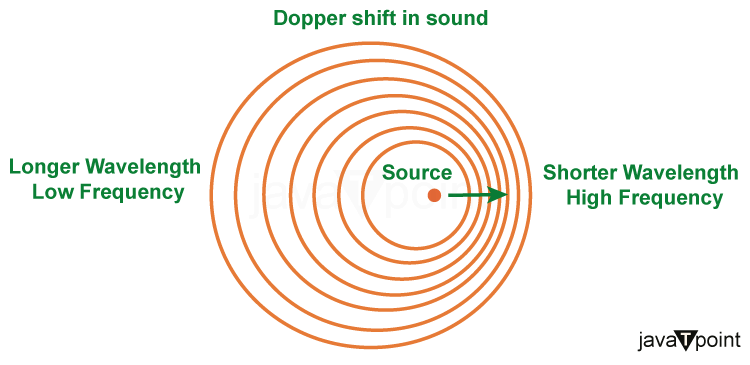Doppler Effect
Introduction:
Picture yourself standing on a busy street corner as an ambulance races toward you with its sirens blaring. As the ambulance draws near your position, the pitch of the siren gets higher, and the magnitude of the sound also increases, and as the ambulance moves away from you, the pitch and the magnitude of the siren get lower and lower. This happens due to the compression of the sound waves. This compression of the waves as the source moves toward the observer is known as the Doppler Effect.
A Brief History of the Doppler Effect:
Long before Christian Doppler's groundbreaking insights, various theorists had laid the groundwork for the concept of frequency changes due to relative motion. Among these early concepts was the work of Dutch mathematician Willebrord Snell, who, in the mid-17th century, proposed that the pitch of sound could change based on the motion of the source and the listener. However, these ideas remained largely theoretical and lacked the empirical foundation to gain widespread recognition.
In the early 19th century, Christian Doppler, an Austrian physicist, introduced the world to a groundbreaking concept that would forever change the way we perceive sound and light. Doppler's insight, now known as the Doppler Effect, stemmed from his understanding of wave behavior and its interaction with relative motion. He proposed that the frequency of a wave (whether it's a sound wave, light wave, or any other type) changes as a result of the relative motion between the source of the wave and the observer

Following Doppler's revelation, scientists and researchers began exploring the practical implications of the Doppler Effect. The phenomenon's first applications were primarily in the realm of sound waves and fluid dynamics. Physicists and engineers utilized Doppler's principles to develop techniques for measuring fluid velocities in pipes and rivers, as well as for assessing blood flow in the human body. These early applications set the stage for the broader reach of the Doppler Effect in diverse fields.
Understanding the Doppler Effect:
The Doppler Effect provides a key insight into how waves change their properties when there's relative motion between the source of the wave and an observer. The Doppler Effect explains how waves "stretch" or "compress" as a result of the relative motion between the source of the wave and the observer. Imagine a wave as a series of crests and troughs that travel through space. When the source of the wave is moving towards the observer, each successive crest is emitted from a slightly closer distance than the one before it.
This results in a compression of the wave, causing the wavelength (the distance between successive crests) to become shorter.
Conversely, when the source is moving away from the observer, each crest is emitted from a slightly farther distance. This leads to stretching the wave, resulting in a longer wavelength. The change in wavelength directly affects the frequency of the wave?the number of crests that pass a given point in a unit of time. A higher frequency corresponds to a higher pitch (in the case of sound waves) or a bluer hue (in the case of light waves), while a lower frequency corresponds to a lower pitch or a redder hue.
Understanding by Examples:
- Passing Siren:
One of the most common examples of the Doppler Effect is the change in pitch of a siren as an emergency vehicle approaches and then passes by. When the vehicle is approaching, the sound waves from the siren get compressed due to the decreasing distance between the vehicle and the observer. This compression leads to a higher frequency and a higher-pitched sound. As the vehicle moves away, the sound waves get stretched out, resulting in a lower frequency and a lower-pitched sound.
- Train Whistle:
When a train approaches a train station, you can observe the Doppler Effect in the sound of its whistle. The sound waves get compressed as the train approaches, resulting in a higher-pitched sound. As the train departs, the sound waves get stretched out, causing the pitch of the whistle to decrease.
- Ripples on the Surface of Water:
When an insect or an animal sitting on the surface of the water makes a sound, ripples occur on the surface of the water. These ripples are perfectly in a circle. But if the animal, let us assume a duck, makes a noise while drifting on the water's surface, one side of the circle gets elongated while the other gets compressed. This is due to the Doppler Effect.

- Sonic Boom:
When an object moves through the air at a speed greater than the speed of sound, it creates a shock wave known as a sonic boom. The Doppler Effect is responsible for the characteristic "double boom" sound experienced by observers on the ground. As the object approaches, the pressure waves from the boom get compressed, resulting in a higher-pitched sound. As the object passes, the waves stretch out, causing the second, lower-pitched boom.
Sound waves are the easiest way to understand the Doppler Effect as we witness them daily. The Doppler Effect applies not only to train whistles and sirens but also to horns and engine racing.
Significance of the Doppler Effect:
The Doppler Effect holds immense significance across various scientific disciplines and practical applications due to its ability to unveil motion through waves. Its impacts range from enhancing our understanding of the universe to revolutionizing technologies that improve our daily lives. Here are some key aspects of the significance of the Doppler Effect:
- Astronomy and Cosmology:
In astronomy, the Doppler Effect plays a crucial role in understanding the motion of celestial bodies, particularly stars and galaxies. When observing light from distant stars, the wavelengths of the light can be affected by the motion of the star itself. If a star is moving away from us, its light waves get stretched out, leading to a "redshift" in the spectrum?the light shifts towards the red end of the spectrum. Conversely, if a star is moving towards us, its light waves get compressed, resulting in a "blueshift," where the light shifts towards the blue end of the spectrum. By analyzing the redshift and blueshift in the spectra of stars and galaxies, astronomers can determine their motion relative to Earth. This information provides insights into the expansion of the universe, the movement of galaxies within galaxy clusters, and even the presence of exoplanets around distant stars.

- Determining Velocities:
The Doppler Effect allows us to calculate the velocities of objects in motion, whether they are stars, galaxies, planets, or even vehicles on Earth. This is crucial for navigation, space exploration, and understanding the dynamics of objects in the universe.
- Weather Tracking and Meteorology:
The Doppler Effect continues to evolve in the modern era, driven by advancements in technology and innovative applications. Initially developed for weather tracking, Doppler radar systems have become essential tools for monitoring severe weather conditions and improving aviation safety. These systems use the Doppler Effect to analyze the frequency shifts of radio waves reflected off particles in the atmosphere, providing valuable data for meteorological forecasting.
- Medical Diagnostics:
In medical applications, Doppler ultrasound is used to visualize blood flow within the body. Ultrasound waves are sent into the body, and the echoes of these waves bouncing off moving blood cells are analyzed. The frequency shift of the echoes due to the motion of blood cells is used to create images showing the speed and direction of blood flow, helping diagnose conditions like vascular diseases.
- Space Exploration and Navigation:
The Doppler Effect plays a critical role in space exploration. It enables precise navigation of spacecraft by tracking the frequency shifts of radio signals transmitted to and from the spacecraft. This technology ensures accurate interplanetary and interstellar travel and the success of missions to other celestial bodies.
- Exoplanet Detection:
In the realm of space exploration, the Doppler Effect has enabled precise navigation of spacecraft and the discovery of exoplanets. Space missions use Doppler tracking to monitor the velocity and trajectory of spacecraft, enabling accurate interplanetary and interstellar travel. Additionally, the Doppler Effect plays a central role in the radial velocity method?a technique used to detect exoplanets by observing the periodic shifts in the spectral lines of host stars.
- Understanding Sound Behavior:
Following Doppler's revelation, scientists and researchers began exploring the practical implications of the Doppler Effect. The phenomenon's first applications were primarily in the realm of sound waves and fluid dynamics. Physicists and engineers utilized Doppler's principles to develop techniques for measuring fluid velocities in pipes and rivers, as well as for assessing blood flow in the human body. These early applications set the stage for the broader reach of the Doppler Effect in diverse fields.

- Fundamental Understanding of Waves:
The Doppler Effect highlights the dynamic relationship between wave behavior and motion. It deepens our understanding of how waves are influenced by their environment and how their properties change based on relative motion, influencing fields beyond astronomy and physics.
- Quantum Mechanics and Relativistic Effects:
In the realm of quantum mechanics and relativistic physics, the Doppler Effect plays a role in understanding particle behavior and the effects of motion at speeds approaching the speed of light. This has implications for particle physics and our understanding of the fundamental nature of the universe.
In essence, the Doppler Effect is a versatile and essential concept that bridges the gap between wave behavior and motion. Its applications extend from unraveling the mysteries of the cosmos to improving our ability to predict the weather, diagnose medical conditions, and navigate through space. This effect enriches our scientific knowledge, enhances our technological capabilities, and enriches our everyday experiences.
Limitations of the Doppler Effect:
While the Doppler Effect is a powerful and versatile concept that has transformed our understanding of motion and waves, it also has some limitations that should be taken into consideration when applying it in various contexts. Here are some key limitations of the Doppler Effect:
- Line-of-Sight Velocity:
The Doppler Effect provides information about the component of motion along the line of sight between the source and the observer. This means that it only gives us information about the motion directly towards or away from the observer. It doesn't provide details about the motion perpendicular to the line of sight, making it difficult to accurately determine an object's full three-dimensional motion.
- Constant Velocity Assumption:
The Doppler Effect assumes that the source of the wave is moving at a constant velocity relative to the observer. In reality, many objects have variable velocities due to acceleration, deceleration, or changing directions. The Doppler Effect may not accurately represent the observed frequency shifts when dealing with rapidly changing or complex motion.
- Dispersive Media:
In some cases, the medium through which the wave travels can affect the Doppler Effect. For example, in a dispersive medium (where different frequencies of the wave propagate at different speeds), the Doppler Effect can lead to more complex frequency shifts that depend on the specific properties of the medium.
- Ambiguity in Astronomical Data:
In astronomy, the redshift or blueshift of an object's spectrum can be caused by a combination of factors. While the Doppler Effect is a significant contributor, other phenomena like gravitational effects (gravitational redshift) and the expansion of space (cosmological redshift) can also influence the observed shifts, leading to some ambiguity in interpreting the data.
- Limitations in Sonic Booms:
In the case of sonic booms, the Doppler Effect explains the characteristic sound changes as an object moves through the air at supersonic speeds. However, the exact nature of the sonic boom is influenced by other factors, such as atmospheric conditions and shock wave interactions, which can complicate the relationship between frequency shifts and the resulting sound.
- Measurement Accuracy:
In practical applications, accurately measuring the frequency shifts due to the Doppler Effect can be challenging, especially when dealing with small shifts or in noisy environments. The accuracy of the measurements depends on the precision of the instruments and the conditions under which the observations are made.
Despite these limitations, the Doppler Effect remains a valuable tool for understanding motion and waves in a wide range of contexts. Its applications, when used appropriately and in conjunction with other information, can provide valuable insights into the dynamics of various systems, from astronomical objects to moving vehicles and beyond.
Conclusion:
The Doppler Effect, a simple yet profound phenomenon, has left an indelible mark on the way we understand motion and waves. It's a reminder that our world is not static but a dynamic interplay of movement and vibrations. From the passing sirens on our streets to the distant stars in our night sky, the Doppler Effect is an ever-present companion, revealing hidden stories of motion that would otherwise go unnoticed.
This effect's significance is far-reaching. In astronomy, it has given us the power to understand the workings of light, letting us understand the stars that are not only far away but are drifting further and further away in the vast expanse of the cosmos. Meteorologists use Doppler radar to study and predict the weather, and using these studies, warn us about incoming weather phenomena that can spell disaster for us. The medical field employs it to visualize the inner workings of our bodies, providing crucial insights into our health.
Yet, the Doppler Effect isn't without its limitations. Its ability to reveal only the motion along our line of sight leaves some mysteries unresolved. In the realm of high speeds, its traditional interpretation bends under the rules of relativity. But even with these limitations, the Doppler Effect remains a faithful guide, a key to understanding a dynamic universe.
|

 For Videos Join Our Youtube Channel: Join Now
For Videos Join Our Youtube Channel: Join Now












